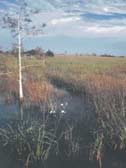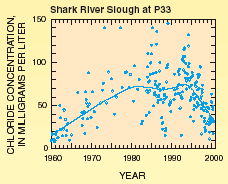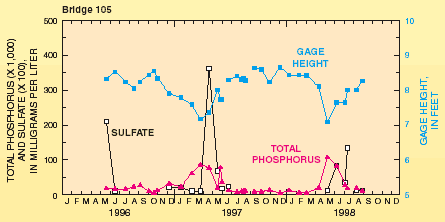Water Quality in Big Cypress National Preserve (BICY) and Everglades National Park (EVER)
Trends and Spatial Characteristics of Selected Constituents
Poster presented April 2003, at the Greater Everglades Ecosystem Restoration Conference
By Benjamin F. McPherson1, Ronald L. Miller1, Robert Sobczak2, and Christine Bates2
1U.S. Geological Survey, Tampa, FL 2National Park Service, Ochopee, FL
| Water quality varies spatially across the region because of natural variations in geology, hydrology, and vegetation and because of differences in water management and land use. Although water quality in BICY and EVER is generally good, major physical alteration of the landscape and associated water management practices in the watershed have altered its quality.
The National Park Service (NPS) maintains hydrologic monitoring stations for measuring the water level (stage) and water quality in BICY and EVER (fig. 1). The data collected at these stations provide a historical baseline for assessing hydrologic conditions and making a wide range of management decisions. We have assessed selected water-quality data at these stations and at nearby canal sites for the period of record, 1959-2000, to define baseline conditions and to evaluate whether long-term trends have occurred. |
 |
| Figure 1 - Major features and sampling sites in Big Cypress National Preserve and Everglades National Park. [larger image] |
Methods and Approach
- Data collected primarily by the South Florida Water Management (SFWMD) and the U.S. Geological Survey (USGS).
- For analysis of trends, we focused on specific conductance, chloride, sulfate, total phosphorus, and total nitrogen at sites with the longest record of water-quality data.
- For trend analysis, we used the USGS S-ESTREND software--uncensored seasonal Kendall test for specific conductance, chloride, and total nitrogen, and Tobit regression test for sulfate and total phosphorus (which have numerous data reported at "less-than" values).
- For evaluation of spatial patterns in water quality, we used median concentrations of selected constituents over a 10-year baseline period (1991-2000).
 |
 |
 |
||
| Big Cypress Swamp [larger image] |
Taylor Slough [larger image] |
Everglades [larger image] |
Major Results from the Analysis of the Historic Water-Quality Data Include:
- Long-term changes in water levels, flows, water management, and upstream land use can affect water quality in BICY and EVER, based on analysis of available data (1960-2000).
- Specific conductance and concentrations of chloride increased in the Taylor Slough (TSB) and Shark River Slough (P-33) over the period of record; for example, chloride concentrations more than doubled from 1960 to 1990 (fig 2), primarily due to greater canal transport of high-dissolved solids water into the sloughs. Chloride did not show a long-term trend at the Everglades reference site P-34 or at Bridge 105 in BICY.
 |
 |
|
| Figure 2-Chloride concentrations and loess smooth line at Taylor Slough Bridge and in Shark River Slough at P-33. [click on each of the graphs above to view a larger image] | ||
- Some of the long-term trends in sulfate and total phosphorus (fig. 3) were likely attributable to high percentages of “less-than” and zero values and to changes in reporting levels over the period of record, rather than to real environmental changes.
- High spikes in nutrient concentrations were evident during dry periods (figs. 4 and 5), and attributable to increased canal inflows of water that is nutrient-rich relative to marsh inflows, to increased nutrient releases from break-down of organic bottom sediment, or to increased buildup of nutrient waste from concentrations of aquatic biota and wildlife in remaining ponds.
 |
| Figure 3-Total phosphorus concentration at P-33. [larger image] |
 |
| Figure 4-Total phosphorus concentration versus water level at P-33. [larger image] |
 |
| Figure 5-Water level at Bridge 105 on Tamiami Trail in BICY and concentrations of total phosphorus (have been multiplied times 1,000) and sulfate (have been multiplied times 100). [larger image] |
- Long-term changes in water quality over the period of record are less pronounced in the western Everglades and the Big Cypress Swamp, however, seasonal and drought-related changes are evident.
- Water quality varies spatially across the region because of natural variations in geology, hydrology, and vegetation and because of differences in water management and land use.
- Nutrient concentrations are relatively low in BICY and EVER compared to concentrations in parts of the northern Everglades which are near agricultural and urban lands.
- Concentrations of total phosphorus (fig. 6) generally are higher in BICY (median values, 1991-2000, were mostly above 0.015 mg/L) than in EVER (median values, 1991-2000, below 0.01 mg/L), probably because of higher phosphorus in natural sources such as shallow soils, rocks, and ground water in the Big Cypress region than in the Everglades region.
- Concentrations of chloride and sulfate (fig. 6), on the other hand, are higher in EVER (median values in Shark River Slough, 1991-2000, mostly above 2 mg/L sulfate and 50 mg/L chloride), than in BICY (median values, 1991-2000, less than 1 mg/L sulfate and at most sites less than 20 mg/L chloride), probably because of the canal transport system that conveys more water from agricultural sources into EVER than into BICY.
- Trace elements and contaminants such as pesticides and other toxic organics are in relatively low concentrations in BICY and EVER compared with concentrations in parts of the northern Everglades which are near agricultural and urban sources.
- Concentrations of pesticides rarely exceeded aquatic life criteria in BICY and EVER (table). Atrazine was the only pesticide that exceeded the criteria (in 2 out of 304 samples). The pesticides heptachlor expoxide, lindane, and p,p'-DDE, exceeded criteria in canal bed sediments in 1, 2, and 16 percent of the samples, respectively.
| Agricultural activities in south Florida | |
 [larger image] |
 [larger image] |
| Site | Number of detections by compounds | Number of determin- ations by compounds |
Detections per determin- ation |
Highest measured con- centration |
Lowest measured con- centration |
Aquatic life criteria | Number of exceed- ances |
Class III criteria, fresh- water |
|---|---|---|---|---|---|---|---|---|
| Atrazine, unfiltered, g/L |
116 | 304 | 0.382 | 13.2 | 0.01 | 1.8 | 2 | |
| Atrazine, filtered, g/L |
90 | 99 | 0.909 | 0.87 | 0.00347 | 1.8 | 0 | |
| Metolachlor, filtered, g/L |
83 | 99 | 0.838 | 0.0635 | 0.0036 | 7.8 | ||
| Deethylatrazine, filtered, g/L |
73 | 99 | 0.737 | 0.0225 | 0.00107 | |||
| Tebuthiuron, filtered, g/L |
61 | 99 | 0.616 | 0.0494 | 0.0027 | 1.6 | 0 | |
| Endosulfan sulfate, unfiltered, g/L |
43 | 374 | 0.115 | 0.45 | 0.0033 | |||
| EPTC, filtered, g/L |
29 | 99 | 0.293 | 0.0148 | 0.00081 | |||
| 2, 6-Diethylaniline, filtered, g/L |
23 | 99 | 0.232 | 0.0054 | 0.00098 | |||
| Simazine, filtered, g/L |
20 | 99 | 0.202 | 0.0979 | 0.00361 | 10 | 0 | |
| Chlorpyrifos, filtered, g/L |
19 | 99 | 0.192 | 0.0234 | 0.00249 | |||
| Endosulfan I, unfiltered, g/L |
17 | 55 | 0.309 | 0.05 | 0.001 | 0 | 0.056 | |
| Malathion, filtered, g/L |
16 | 99 | 0.162 | 0.0837 | 0.00324 | 0.1 | 0 | 0.1 |
| Hexazinone, unfiltered, g/L |
15 | 153 | 0.098 | 0.031 | 0.019 |
![]() Click here for a printable version of this poster (note: document will
open in a new browser window)
Click here for a printable version of this poster (note: document will
open in a new browser window)
![]() Click here to download an 8.5 x 11 PDF version of the original poster (2.4 MB). PDF files require the Free Adobe Acrobat Reader ® to be read.
Click here to download an 8.5 x 11 PDF version of the original poster (2.4 MB). PDF files require the Free Adobe Acrobat Reader ® to be read.
Related information:
SOFIA Project: Analysis of Historic Water-Quality Data



